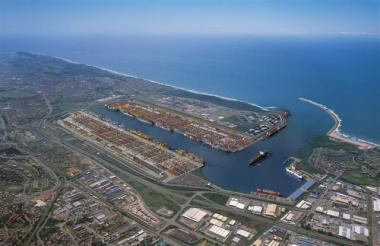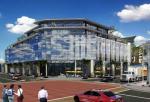Old Durban International Airport site handed over to Transnet
 The proposed R100bn development of a dugout port at the old Durban International Airport.
The proposed R100bn development of a dugout port at the old Durban International Airport.
The old Durban International Airport (DIA) has been handed over to Transnet to meet the demand for container capacity in Durban.
Speaking at an official handover of the DIA site from ACSA to Transnet, for the development of a new Dig-Out Port on Thursday, Minister of Public Enterprises Malusi Gigaba said the demand for container capacity was estimated to grow from 2.5 million twenty-foot equivalent unit (TEUs) to 12 million TEUs over a 30-year period.
Once transformed, the DIA will drive industrialisation through investment in the port and related sectors such as construction. It will become home to 16 container berths, five automotive berths and four liquid bulk berths.
It is expected to create 20 000 direct and 47 000 indirect jobs during the construction phase. Once operationalized, it will employ 12 000 people directly and another 16 000 indirectly through the value chain of suppliers.
Transport Minister Dikobe Ben Martins, said the ceremony was an example of co-operation between government departments and enterprise in pursuit of the common goal to accelerate infrastructure development in South Africa.
“The new port will have a positive impact on the national economy, and contribute to regional integration in Southern Africa. In addition to its direct impact on the movement of goods, the port will also contribute to the development of the maritime industry.
“The Department of Transport is working on a strategy to industrialise the country’s maritime heritage,” Martins said.
Gigaba further added that in Cape Town, Transnet was planning to grow the port capacity from 700 000 TEUs to 2.5 million TEUs in 30 years, with Port Elizabeth and Ngqura expected to become a core transhipment port, with a capacity of 6 million TEUs in 2042.
The minister highlighted government’s national infrastructure plan intended to transform the economic landscape of South Africa and create a conducive environment for state-owned companies to pursue initiatives expected to build new skills capacity, create decent jobs, enterprise development and support the integration of African economies.
“Above all else, this integrated infrastructure programme must and will lead to the industrialisation of our economy and thus will move our economy to a higher trajectory where we can shift away from exporting primary commodities and importing manufactured products, and begin ourselves to develop a vibrant manufacturing sector in South Africa and to export value-added goods.
“This infrastructural development is within the Strategic Integrated Project 2 (SIP2), which is under the leadership of the Presidential Infrastructure Coordinating Commission (PICC).
“The country’s infrastructure rollout plan consists of 18 strategic integrated projects that will cost about R4 trillion that must come both from the public and private sectors,” Gigaba said.


















